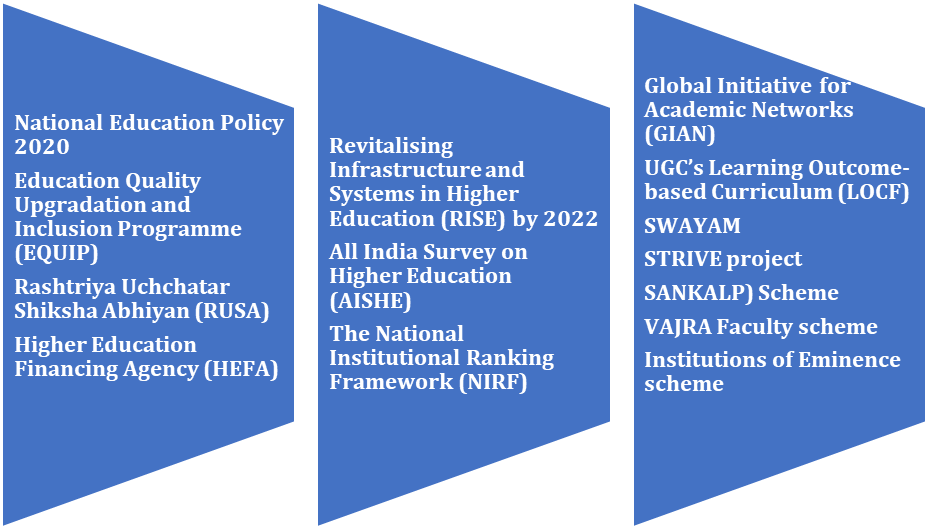Mains > Social justice > Education > Higher education
Syllabus
GS 2 > Social justice > Education > Higher education
REFERENCE NEWS
Reports by private agencies state that fewer than half of India’s graduates were employable in 2021. According to the Periodic Labour Force Survey, the unemployment rate among graduates is higher than in many other developing countries.(The Hindu)
STATISTICS:
All India Survey on Higher Education (AISHE) for the year 2020-2021 has revealed significant developments in India's higher education sector:
CHALLENGES TO HIGHER EDUCATION IN INDIA:
| Low enrolment ratio |
|
Equity
|
|
Pupil-teacher ratio
|
|
Teacher vacancies
|
|
| Poor research ecosystem | Poor fund allocation in research: India’s investment in R&D has remained constant at around 0.6% to 0.7% of India’s GDP. This is below the expenditure of countries like the US (2.8), China (2.1), Israel (4.3) and Korea (4.2). Questionable quality of research: India has emerged as one of the biggest markets for ‘predatory journals’. Researches published are riddled with issues of plagiarism and data manipulation. Moreover, Indian Higher education institutions are poorly connected to research centres. Other issues related to research: Low levels of PhD enrolment, fewer opportunities for interdisciplinary and multidisciplinary research, low quality of research work, etc. are some of the factors affecting the research ecosystem in India. |
Lack of employable skills
| As per NITI Aayog, only 5.4% of India’s workforce has undergone skill training compared to 75% in Germany and 96% in South Korea. According to the Annual Employability Survey 2019 report by ‘Aspiring Minds’, 80% of Indian engineers are not fit for a job in the knowledge economy. This arises mainly due to the focus on rote learning and outdated curriculum taught at colleges. |
| Limited financial resources | Bulk of the enrolment in higher education is handled by state universities and their affiliated colleges. However, nearly 65% of the UGC budget is utilized by the central universities and their colleges, while state universities and their affiliated colleges get only the remaining 35%. |
| Lack of University-Industry Linkage (UIL) | In research conducted by the PHD Chamber of Commerce & Industry and Ministry of Science & Technology, the UIL of India is 4.7 on a scale of 10. It shows the absence of appropriate schemes and policies by the government that would support the cause. |
| Outdated Curriculum | Outdated, irrelevant curriculum that is dominantly theoretical in nature and has a low scope for creativity. There is a wide gap between industry requirements and universities’ curriculum that is the main reason for the low employability of graduates in India. |
Accountability and performance of teachers:
| At present, there is no mechanism for ensuring the accountability and performance of professors in universities and colleges. This is unlike foreign universities where the performance of college faculty is evaluated by their peers and students. |
| Regulatory Issues | As a result of increase in number of colleges and students, the burden of administrative functions of universities has significantly increased. Due to this, the core focus on managing academics and ensuring quality got diluted. Moreover, management of the Indian education faces challenges of over-centralization, bureaucratic structures and lack of accountability, transparency, and professionalism Also, governing such as the UGC is riddled with allegations of corruption and nepotism. |
Low public spending
| India spends 4.6% of its total GDP on education, against the recommended level of 6%. While private sector has been involved, it has led to the mushrooming of a large number of sub-standard colleges and deemed universities. |
Weak school education system
| School is the foundation of higher education in all societies. However, the Indian education system emphasize on rote learning without application-based knowledge and field practical information. This limits free thinking and creation of novel ideas. |
| Political interference | Appointments to various premier institutes have been marred by allegations of favoritism. Campus politics further constricts the focus on academics. |
STEPS TAKEN UP

WAY FORWARD
Thus, the transformation of India's higher education sector into a more dynamic and inclusive system is pivotal for harnessing its demographic dividend. By addressing structural challenges and fostering innovation and skill development, India can pave the way for a future where its graduates are not only educated but truly empowered and employable.
PRACTICE QUESTION
Q: Analyse the current status of graduate unemployment in India, and critically evaluate the structural deficiencies in the nation's higher education sector that may be contributing to this issue. (15M, 250W)